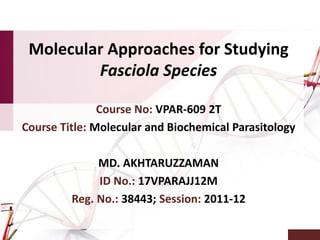
Molecular study of fasciola spp
- 1. Molecular Approaches for Studying Fasciola Species Course No: VPAR-609 2T Course Title: Molecular and Biochemical Parasitology MD. AKHTARUZZAMAN ID No.: 17VPARAJJ12M Reg. No.: 38443; Session: 2011-12
- 2. Introduction Molecular methods are ideal for species identification, strain confirmation and population genetic studies. Most of these molecular methods are polymerase chain reaction (PCR) dependent targeting a common gene which is adequately divergent between taxa. The targeted region must be long enough to provide adequate variable characters to appreciate differences and similarities for analysis .
- 3. Fascioliasis The species of genus Fasciola are the common liver flukes of a wide range of animals. Severe negative economic impact due to fascioliasis has been estimated in ruminants. Commonly three Species are found- Fasciola hepatica Fasciola gigantica Fasciola jaksoni Advanced techniques for identification and determining the phylogeny of parasites have been developed. Molecular methods include microsatellites and the analysis of ribosomal and mitochondrial DNA sequence markers. Markers have been used in separating Fasciola gigantica from F. hepatica in various hosts using the nuclear ribosomal internal transcribed spacers (ITS) 1 and 2.
- 5. Markers for Fasciola species Molecular studies of a variety of organisms, including Fasciola, have been carried out based on following markers - 1. Mitochondrial DNA (mtDNA) 2. Ribosomal DNA (rDNA) 1. Mitochondrial DNA markers : Mitochondrial CO1 & ND1 has been used in genotypic and species identification of Fasciola spp. They are useful in determining genetic diversity of flukes.
- 6. Markers for Fasciola species 2. Ribosomal DNA (rDNA) markers : The nuclear rDNA markers (ITS-1 and ITS-2) are located between the 18S, 5.8S and 28S ribosomal RNA genes. They are useful in the identification and confirmation of Fasciola species. The ITS-1 marker has been useful in the differentiation of F. hepatica and F. gigantica.
- 7. Common Molecular Approaches DNA probes: Before the availability of PCR-based approaches, DNA probes were the alternative choice for the genotypic detection of Fasciola spp. Sequence Related amplified Polymorphism (SRAP): The SRAP technique is useful for revealing genetic variability within and between F. hepatica and F. gigantica. Randomly amplified polymorphic DNA (RAPD): RAPD is a useful technique for the identification and differentiation of F. hepatica and F. gigantica.
- 8. Common PCR based assays Over the last two decades, several PCR-based assays have been developed for the accurate identification of Fasciola spp including- a) PCR-linked restriction fragment length polymorphism (PCR-RFLP) b) PCR-linked single-strand conformation polymorphism (PCR-SSCP) c) Fluorescence-based SSCP (F-PCR-SSCP) PCR-RFLP: This assay targeting a 618-bp sequence of the 28S rDNA was developed for the differentiation between F. hepatica and F. gigantica. A similar PCR-RFLP assay using restriction endonucleases Hsp92 II and Rca I was developed to differentiate between F. Hepatica & F. gigantica.
- 9. Specific PCR assays Recently, several specific PCR assays have been developed to differentiate and detect F. hepatica and F. gigantica infection. Specific PCR method based on the ITS-2 sequences Specific PCR assays, using two primer sets derived from RAPD sequences Taq-Man based real-time PCR A multiplex PCR assay Loop-mediated isothermal amplification (LAMP) allows amplification of target nucleic acids under isothermal conditions with high sensitivity, specificity, rapidity and precision
- 10. Specific PCR assays Sampling: Liver flukes are collected from abattoirs that have a large slaughter capacity. DNA extraction: Approximately 25mg of each fluke usually used for DNA extraction using a DNeasy® DNA Blood and Tissue Kit (Qiagen). Spectrophotometry: Spectrophotometry is used to quantify the fluke DNA samples. One μl of double-deionised water was used to zero a Nanodrop Spectrophotometer and 1μl of AE buffer from Qiagen then used to calibrate the instrument. One μl DNA solution was added and the concentration determined.
- 11. Specific PCR assays Polymerase chain reaction (PCR): • The PCR amplifications for both markers are performed in 25μL volumes. Each reaction contained 4μL of DNA, 11μL of sterile water, 8μL of TopTaq master mix (QIAGEN) and 1μL of each primer per reaction. • PCR should be performed in a thermocycler under the following conditions: 94°C for 5 min (initial denaturation), followed by 40 cycles at 95°C, 1 min (denaturation), 1 min (annealing), 72°C, 1 min (extension), and a final extension of 72°C for 7 min. • The annealing temperature is 55°C for the ITS region and 59°C for the CO1 region. • An aliquot (8μl) of the reaction products then electrophoresed through a 1% agarose gel in order to allow separation and isolation of the amplification products. The amplified ITS and CO1 bands are selected by their positions relative to the co-electrophoresed molecular weight marker and excised from the gel. The excised bands are stored in a 1.5ml microfuge tube at -20°C ready for sequencing.
- 12. Specific PCR assays DNA sequencing: DNA fragments should be sequenced in the forward and reverse directions using the primers used in the initial amplification
- 13. Conclusions Conventional methods of detection and differentiation of Fasciola do not accurately reflect the full diversity of Fasciola spp. Molecular genetics studies over the past two decades have added significantly to our understanding of Fasciola taxonomy and genetics. These knowledge contributed to the development of advanced approaches for the accurate identification and differentiation of Fasciola spp.
- 14. References S. Mas-Coma, M. D. Bargues, and M. A. Valero, “Fascioliasis and other plant-borne trematode zoonoses.” S. Mas-Coma, M. A. Valero, and M. D. Bargues, “ChapternFasciola, lymnaeids and human fascioliasis, with a global overview on disease transmission, epidemiology, evolutionary genetics, molecular epidemiology and control.” M. A. Valero,N.A.Darce,M.Panova, and S.Mas-Coma, “Relationships between host species and morphometric patterns in Fasciola hepatica adults and eggs from the northern Bolivian Altiplano hyperendemic region.” K. Tamura, D. Peterson, N. Peterson, G. Stecher, M. Nei, and S. Kumar, “MEGA5: molecular evolutionary genetics analysis using maximum likelihood, evolutionary distance, and maximum parsimony methods.” W. Y. Huang, B. He, C. R. Wang, and X. Q. Zhu, “Characterisation of Fasciola species from Mainland China by ITS-2 ribosomal DNA sequence.”
- 15. Thank You
